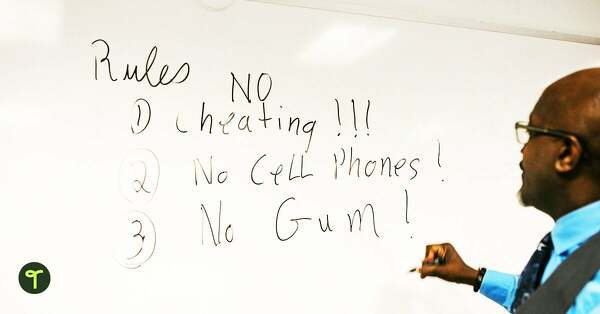What is a hexagon? If you’re teaching geometry in your math classes this school year, you may need to brush up on the various shape names and properties before diving in. So let’s get started! A hexagon is a two-dimensional shape with six sides and six angles.
That also means that hexagons are polygons. Polygons are flat two-dimensional shapes with straight sides. Polygons enclose a space, and they do not have any curved sides.
From types of hexagons to hexagon properties, the teachers on the Teach Starter team have put together this comprehensive guide to all things hexagonal! Read on for some hexagon facts and examples of hexagons that your students might be able to identify from their everyday lives!
How Many Sides Does a Hexagon Have?
As we mentioned above, the hexagon shape has six sides, making it a six-sided polygon.
The “hex” portion of the word is what reminds us that it has 6 sides. After all, hex is from the Greek ἕξ, meaning “six.” The rest of the word for this shape is also from the Greek γωνία, gonía, meaning “corner angle.”
This unique shape is considered one of the strongest shapes to use in construction and design! That’s because hexagons can be lined up against one another without any wasted space due to their unique make-up.
5 Types of Hexagons
There are five main types of hexagons that your students may encounter. Hexagons can be:
- Regular
- Irregular
- Concave
- Convex
- Complex
Teaching about 2D shapes? Explore our 2D Shape teaching resource collection!
What Is a Regular Hexagon?
A regular hexagon is a closed-shape polygon with six equal sides and six equal angles. Every regular hexagon can be identified by specific properties.
In order to be considered a regular hexagon, an object must:
- Be a plane figure
- Have six straight sides
- Enclose a space
- Have six interior angles measuring 120 degrees each
- Have all interior angles equal to a total sum of 720 degrees
What Is an Irregular Hexagon?
Just as the name implies, an irregular hexagon is a 6-sided polygon that is not regular. This means that the sides and angles are not equal, however other characteristics of hexagons still apply. For example, the irregular hexagon is still two-dimensional and the sides are made up of straight lines.
What Is a Concave Hexagon?
You might recognize concave hexagons on the jacket of some military members or even on the arm of a police officer in your town. These six-sided shapes have a deep indentation in them, but they still qualify as a polygon.
In order to be described as concave, a hexagon will have at least one internal angle that is greater than 180 degrees.

Hexagon Shape Examples in Real Life
Are you looking for a few examples of hexagon shapes that can be found in the real world to share with your students?
The most commonly known natural hexagon is a honeycomb, found in beehives. Bees are skilled at constructing uniform hexagons. Bees’ eyes are made up of many thousands of hexagonal lenses.
Here are some more common hexagon shapes your might challenge your students to find!
- Snowflakes — If you’re located in a wintry climate, have your students look closely at a snowflake. They might just see this six-sided shape appears due to the way water molecules arrange themselves when freezing. You can also practice making paper snowflakes in the classroom by folding and cutting paper to end up with hexagonal shapes.
- Stop signs — The bright red stop sign is one of the more noticeable hexagons out in real life.
- Soccer ball panels — The light-colored panels on a soccer ball are — you guessed it — hexagons! A traditional soccer ball then has pentagonal shapes making up the darker sections.
- Nuts and bolts — Head into your tool chest or ask the custodial staff if they have any spare nuts and bolts lying around. Many have hexagonal heads, making them easier to grip and turn.
Symmetry of Hexagons
Typically symmetry lessons in elementary school do not extend into the symmetry of hexagons, but you may have an advanced student who is eager to learn more! A regular hexagon has six rotational symmetries (rotational symmetry of order six) and six reflection symmetries (six lines of symmetry).
The longest diagonals of a regular hexagon, connecting diametrically opposite vertices, are twice the length of one side of the shape.
Diagonals of a Hexagon
A diagonal is a line joining two opposite corners of a straight-sided shape. For regular hexagons, the nine diagonals form into six equilateral triangles.
The formula to find the diagonals of hexagons is:
- n (n-3)/2, where n is the number of sides of a polygon.
- For a hexagon, n = 6, and 6 (6-3) / 2 equals nine diagonals.
A radius of a hexagon is the center point of the hexagon to one of its corners.
Are Hexagons Tessellating Shapes?
Shapes that tessellate can be repeated across a surface without leaving gaps or overlapping. These shapes have straight sides which can sit up against one another. Triangles and squares tessellate; circles and pentagons do not. Hexagons (which are themselves composed of tessellated triangles) do tesselate.
Because hexagons are tessellating shapes, these geometric shapes are often used in tiling patterns and in construction. Look around the floor of your school. You may be able to spot some hexagons to share with your class!
Hexagon Activities for the Classroom
Teaching about hexagons? Try these shape activities with your students to get them excited about the six-sided polygon!
[resource:5001223] [resource:4951311] [resource:2668294]








Comments